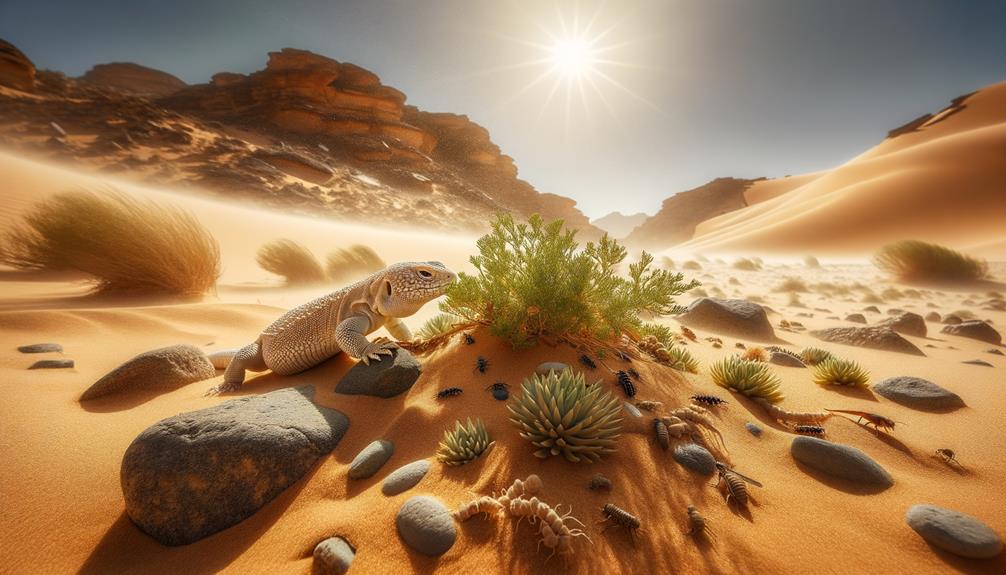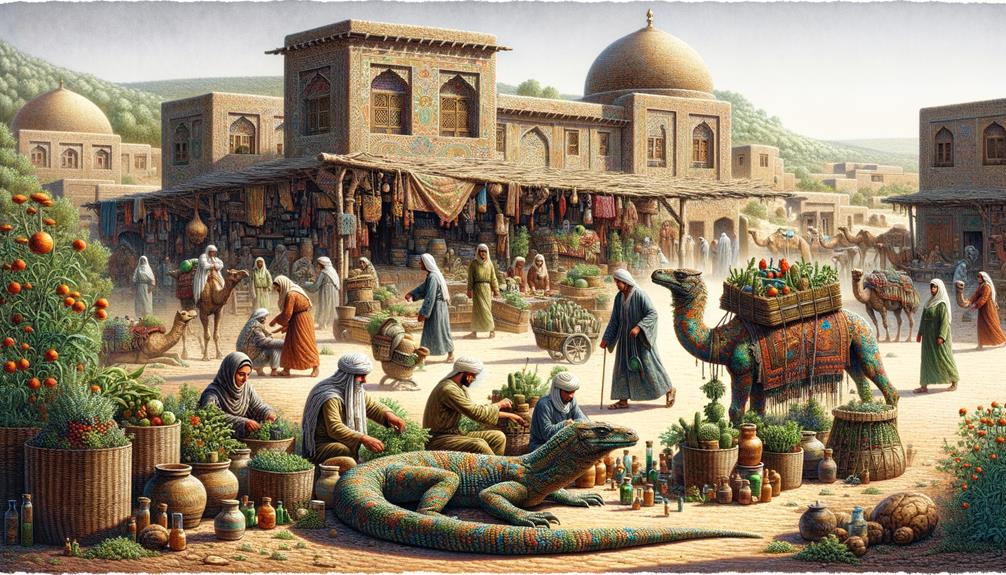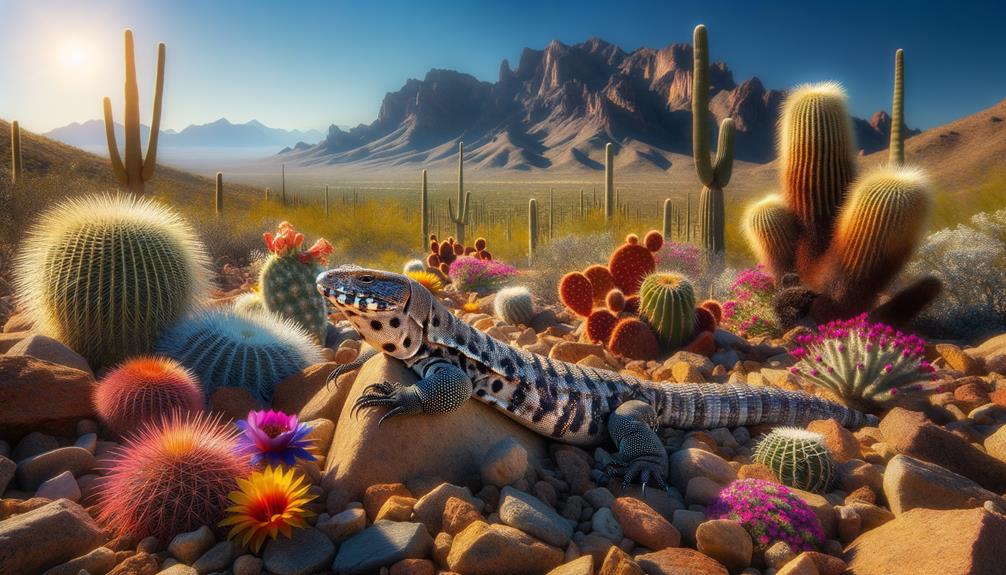In the Thar Desert, the Indian spiny-tailed lizard has developed remarkable adaptations to thrive in this harsh environment. Its burrows provide shelter to other species, highlighting its key role in the ecosystem. To conserve water, a critical resource in this arid landscape, the lizard has developed efficient strategies. Its ability to tolerate high temperatures and blend into its surroundings enables it to regulate insect and rodent populations, maintaining the desert's delicate balance. The presence of this lizard indicates a healthy desert ecosystem. The intricate relationships between these scaly specialists and their environment reveal the secrets to their resilience in this unforgiving landscape.
Key Takeaways
Indian spiny-tailed lizards play a vital role in the Thar Desert ecosystem, providing shelter and maintaining the delicate balance of nature.
Reptiles in the Thar Desert are crucial in controlling rodent and insect populations, which helps maintain ecological stability.
These desert dwellers have adapted to survive the harsh conditions, with heat tolerance and water conservation strategies that enable them to thrive.
Their camouflage abilities also help them evade predators and hunt prey efficiently.
A healthy reptile population is a strong indicator of the overall ecological health of the Thar Desert.
Unique Adaptations
Unique adaptations enable desert plants like Khejri, Kharo Jaal, Neem, and Ber to flourish in the harsh conditions of the Thar Desert. The region's scorching temperatures, limited water availability, and sandy soil make it a challenging environment for living organisms. However, these plants have developed remarkable strategies to survive and thrive.
The Khejri tree's extensive root system allows it to tap into underground water sources, sustaining it during prolonged dry periods. Its fleshy leaves minimize water loss, a vital adaptation in this water-scarce region. Similarly, the Kharo Jaal's dense canopy provides shelter and shade for small creatures, coping with the desert's extreme heat.
The Neem tree, though not native, has adapted remarkably well to the Thar. Its semi-evergreen foliage helps it survive the high temperatures. The Ber tree's spiny thorns and variable leaf sizes ward off herbivores and reduce transpiration. Each species' unique adaptations ensure they thrive and contribute to the daily activities of the region's ecosystem.
These remarkable adaptations guarantee the survival and continuity of these desert plants, allowing them to master the harsh conditions of the Thar Desert.
Water Conservation Strategies

The Thar Desert's unique plants have developed sophisticated water conservation strategies to survive in the arid environment. Key species like khejri, kharo jaal, ber, and neem have evolved remarkable adaptations to navigate water scarcity.
Khejri trees stand out with their evergreen, fleshy leaves that reduce water loss through transpiration. The dense canopy of kharo jaal provides shade, protecting smaller organisms and contributing to water conservation. Ber trees, with their small, variable leaf sizes and spiny branches, minimize water loss and deter herbivores, enhancing their resilience. Neem trees, although not native, have adapted well to this environment through their resilience and medicinal properties.
These plants' water conservation strategies are summarized below:
| Plant | Adaptation | Benefit |
|---|---|---|
| Khejri | Evergreen, fleshy leaves | Reduced water loss |
| Kharo Jaal | Dense canopy shade | Protection from sun |
| Ber | Small, spiny leaves | Minimized water loss |
| Neem | Resilience | Enhanced survival |
These strategies highlight the intricate balance these plants maintain to thrive amidst the Thar Desert's water scarcity.
Seasonal Life Cycles

In the Thar Desert, plants have adapted to the brief and unpredictable rainy seasons, developing strategies to conserve water and survive in this harsh environment. To cope with the arid conditions, they've evolved unique life cycles and behaviors.
Some plants, like Tephrosia and Tribulus, complete their life cycle within a single rainy season. They germinate, flower, and produce seeds rapidly, ensuring their survival before the dry period returns. In contrast, perennial plants like Calligonum and Haloxylon can remain dormant for years, growing and reproducing only when conditions are favorable.
Succulents, such as Euphorbia and Aloe, have developed efficient water storage mechanisms in their leaves and stems, enabling them to survive extended dry periods. Desert shrubs like Prosopis and Capparis also employ a strategy to minimize water loss by shedding their leaves during droughts.
These adaptations highlight the intricate balance and resilience of Thar Desert flora, showcasing their sophisticated survival techniques.
Ephemeral life cycles: Rapid reproduction within a single rainy season.
Dormant perennials: Growth only during favorable conditions.
Water storage succulents: Sustenance through extended dry periods.
These strategies underscore the intricate balance and adaptability of Thar Desert flora to seasonal changes, highlighting their sophisticated survival techniques.
Ecological Importance

As we delve into the fascinating world of Thar Desert fauna, it becomes clear that reptiles, such as lizards and snakes, play a vital role in maintaining the delicate balance of this arid ecosystem. These scaly creatures are not just surviving – they are essential players in this unique environment. By controlling rodent and insect populations, they ensure that the desert remains a thriving and balanced environment.
The Indian spiny-tailed lizard, for example, is a keystone species. Its burrows provide shelter not just for itself, but also for other desert inhabitants, thereby enhancing biodiversity. Reptiles have evolved remarkable adaptations, such as heat tolerance and water conservation, which enable them to survive in extreme conditions. Camouflage is another crucial adaptation that helps them evade predators and hunt efficiently.
| Adaptation | Ecological Role |
|---|---|
| Heat Tolerance | Surviving extreme desert temperatures |
| Water Conservation | Thriving with minimal water sources |
| Camouflage | Evading predators and efficient hunting |
The presence of healthy reptile populations is a strong indicator of ecological health in the Thar Desert. Their ability to adapt and maintain ecological balance underscores their indispensable role in this unique ecosystem. Understanding these dynamics is crucial to appreciating the desert's resilience and beauty.
Human Utilization

In the Thar Desert, human communities, particularly nomadic pastoralists and agriculturalists, have cleverly utilized the resilient flora to access essential resources like food, shelter, and medicine. These desert plants, with their unique adaptations, are vital in supporting these communities' way of life.
The Khejri tree (Prosopis cineraria) stands out as a vital resource. Its leaves and pods serve as a food source, while its wood is used for construction and fuel. Additionally, its medicinal properties are well-documented, providing remedies for various ailments. Similarly, Tecomella undulata, known for its dense canopy, offers shade and shelter, crucial for both humans and livestock in the harsh desert climate. Its wood is prized for carpentry, being used in making furniture and tools.
Neem (Azadirachta indica) is another cornerstone species in the Thar region. Its parts, from leaves to bark, are utilized for their medicinal properties, treating a range of ailments, from skin conditions to infections. The Ber tree (Ziziphus mauritiana) provides nutritious fruits and thorny branches that serve as natural fencing.
- Food: Khejri pods, Ber fruits.
- Shelter: Tecomella undulata canopy, Neem tree.
- Medicine: Neem leaves, Khejri bark.
These plants' deep-rooted systems and hardy characteristics ensure their survival and continual support for human life in the Thar Desert.
Frequently Asked Questions
How Does the Thar Desert Affect the People?
Living in the Thar Desert is a daily struggle. The scorching heat, limited water supply, and frequent sandstorms take a toll on my health. I'm prone to infections, skin disorders, and diseases due to poor hygiene and inadequate healthcare. As a nomad, my daily survival is a constant challenge, affecting my overall well-being.
What Illnesses Can You Get in the Desert?
Imagine the harsh, relentless desert sun beating down on you. In this unforgiving environment, illnesses like fungal infections, bacterial infections, viral warts, scabies, and desert sweat dermatitis can strike. The extreme heat, poor sanitation, and close contact with livestock create a perfect storm for these conditions to arise.
What Is the Rank of Thar Desert in the World?
The Thar Desert stands as the 17th largest desert globally, covering significant parts of India and Pakistan. Its harsh beauty and resilience are a testament to its vastness. Notably, it's also the 7th largest subtropical desert and the 9th hottest, making it a unique and fascinating region.



